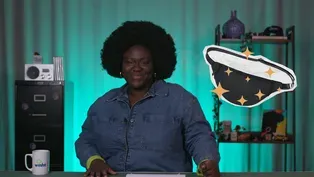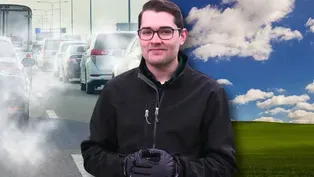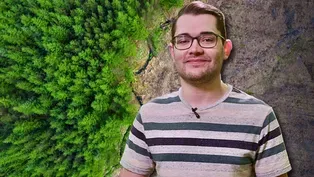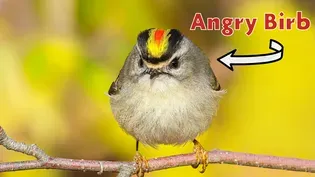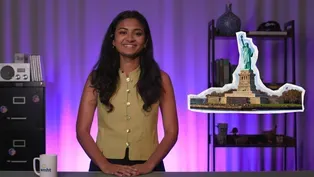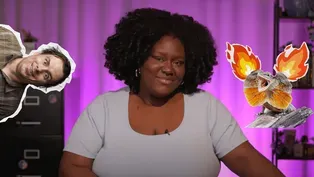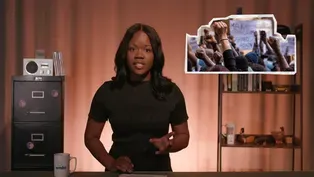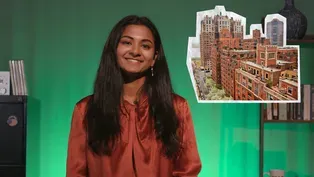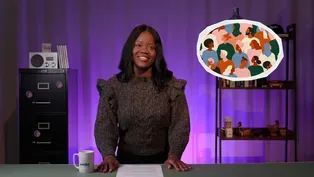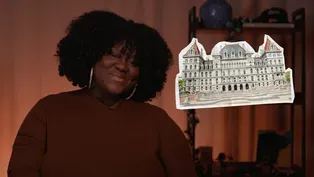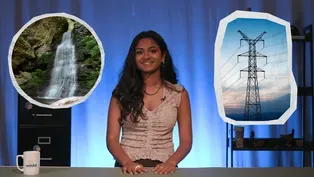
What Does Climate Change Mean for the Hudson River? | NY& Climate
Clip: Special | 8m 42sVideo has Closed Captions
Explore the Hudson River's climate and pollution challenges and efforts to improve it.
Join host Dana Wright and explore New York's relationship with the Hudson River- how climate change plays a role, and how we are cutting back on the pollution we subject it to.
Problems with Closed Captions? Closed Captioning Feedback
Problems with Closed Captions? Closed Captioning Feedback
New York NOW is a local public television program presented by WMHT

What Does Climate Change Mean for the Hudson River? | NY& Climate
Clip: Special | 8m 42sVideo has Closed Captions
Join host Dana Wright and explore New York's relationship with the Hudson River- how climate change plays a role, and how we are cutting back on the pollution we subject it to.
Problems with Closed Captions? Closed Captioning Feedback
How to Watch New York NOW
New York NOW is available to stream on pbs.org and the free PBS App, available on iPhone, Apple TV, Android TV, Android smartphones, Amazon Fire TV, Amazon Fire Tablet, Roku, Samsung Smart TV, and Vizio.
Providing Support for PBS.org
Learn Moreabout PBS online sponsorship- I have long been fascinated by New York's relationship with the Hudson River.
Stretching from the Adirondacks down to New York City, it is a highlight of the state and the capital region, but despite being a defining resource, we unfortunately have a history of treating it like crap, not just figuratively speaking but literally as well.
And with climate change continuing to progress, both the river's ecosystem and communities along the Hudson are dealing with challenges like rising water levels.
So I wanted to take a deeper dive into our complicated relationship with the river.
To do this we'll look at climate change's impacts on the river, ways we can improve our pollution levels, and ultimately, what the river means to us.
I decided to begin my exploration of the Hudson by meeting up with Salme Cook, a scientist at the USGS Water Science Center, to talk about the effects of climate change on the river.
- The Hudson River is an estuary up until the dam at Troy.
An estuary is a semi-enclosed body of water that has a free connection to the ocean that is fed by rivers or a river.
And so the estuarine portion of the Hudson has unique climate challenges because it is affected by the ocean.
So any sort of climate issues that the ocean is experiencing, the Hudson River will also experience.
One of the projects I work on related to the Hudson River is the Hudson River Salt Front study, and it is actually looking at how higher river discharges, sea level rise and tides interact to increase or decrease salinity distribution within the Hudson River.
There are a couple consequences of higher salinity in the Hudson River estuarine portion.
So in the summer and fall months, we see a decrease in river discharge and an increase in salinity.
So any organism that sort of relies on fresher water in certain parts of the year is now experiencing higher salinity ranges.
And so they can become stressed and affect their migration, their reproduction, their growth rate.
- Organisms in the river are also dealing with warming water temperatures, which when paired with changing salinity levels can create a host of challenges.
- For example, oysters in estuarine systems are really suited to particular salinity ranges and temperature ranges.
So when you are now changing when that salt range happens and where it happens, you now stress oyster populations out and oysters are connected to the ground, so they can't move as freely as other organisms and so they become more stressed during big temperature shifts.
If you have increased water temperatures, you start to have a higher prevalence of things like vibrio, which is a disease that will affect the aquaculture of oysters.
Also, when you have higher water temperatures, sometimes you can have less light coming through the water column.
And so that can affect the growth of subaquatic vegetation.
- It's not just aquatic species in the river that are being affected by climate change, but us well.
With rising sea levels and worsening storm events, lots of communities along the Hudson and other waterways are facing an increasing risk of flooding.
If you think back to our episode on air quality, the DEC highlighted communities in the capital region that could be at risk of higher levels of aerosol pollution.
A lot of those same communities are also at risk of experiencing flood events as well.
New York's climate scoping plan highlights a range of actions that could be taken to address this issue from updating building and safety codes, to creating a resilient infrastructure fund that invests in disadvantaged communities to finding ways to protect natural flood barriers, like stream buffers and marshland.
But these climate issues aren't what give the river a bit of an icky reputation.
That would be from the pollution it has historically been subjected to, like companies dumping PCBs into the water.
But another well-known form of pollution comes in the more stinky variety.
It's called combined sewage overflow, which is the result of local cities like Troy and Albany having sewer systems that combine standard wastewater and storm water.
I'll let Joseph Coffey, commissioner of Albany's Department of Water do the explaining.
- In Albany, like many communities, the combined sewers were just really a function of open streams that had been containing sewage being piped into the river.
Sewage treatment plants were built along at the ends of these pipes along the river and they had collected both rainwater and normal sanitary sewage.
When you get some storms are pretty dramatic, there's a lot of heavy rain, that'll exceed the capacity of the wastewater treatment plant.
These combined sewers are gonna overflow and discharge into the Hudson River.
- Simply put, if there's heavy rain in the capital region, untreated sewage is going into the Hudson.
I was despondent when I first learned this information and was brimming with questions.
How could we do this to our river?
Can anything be done to fix it?
If I flush a toilet during a rainstorm, am I just slingshotting waste right towards some unsuspecting carp?
Thankfully, Commissioner Coffey informed me of the Beaver Creek Clean River Project, which is a satellite treatment facility right here in Lincoln Park.
It is set to dramatically decrease our negative impact on the Hudson's cleanliness.
- The Beaver Creek Clean River Project is part of a larger approach to the combined sewer overflow impacts that the local communities had on the Hudson River.
I think everyone's aware of the fact that the Hudson River is not exactly what you call drinkable, swimable, fishable, and a lot of it is because of the combined sewer overflows.
The six communities along the Hudson River, Albany, Rensselaer, Troy, Cohoes, Green Island and Watervliet collectively elected to address it collaboratively.
So Beaver Creek is the largest of the projects.
We're the largest of the pool communities.
It's essentially a satellite treatment facility.
The goal was to get about 300 million gallons of combined sewage out of the system of the river over the course of the year.
And that's treating it.
That's separating and screening the debris that's in the catch basins, the bottles, the plastic, and God knows what else is in there.
In Beaver Creek's case, we're actually disinfecting the combined sewage that goes through the facility.
So it has a benefit of not just screening the materials, but it's also disinfecting and really getting the bacteria, et cetera, out of the system before it goes into the river.
We had this conversation with the community and they said why are you putting this facility in a park and in our neighborhood, the existing Beaver Creek trunk sewer that flows through Lincoln Park, it would just dump untreated wastewater into a ravine.
It was not healthy for children or anyone really to have contact with the soil in that part of the park.
It was a horrific odor for the folks that lived along Park Avenue.
Why would we let something like that persist?
So by actually locating the facility where we did in that part of Lincoln Park, we were able to treat and address that longstanding social justice, environmental justice issue.
- The facility, once operational, will address around 85% of the overflow impact on the Hudson.
And there's a great example of local municipalities making an effort to improve the cleanliness of our wonderful river.
So we've looked at the climate impacts on the river, as well as pollution solutions.
But before we wrap up, I wanted to emphasize how lucky we are to have such a great resource run through our entire region.
And I know I'm not the only one who is appreciative of it.
I thought it would be fun to share some of the locals' responses to what comes to mind when they think of the Hudson River.
So when I say Hudson River, what is the first thing that comes to mind?
- Bald eagles 'cause I like birds.
I've been seeing some bald eagles there recently.
- Tug boats.
- I always think of trade and Fort Orange.
- People coming down and having a good time on the river, whether it be kayaking or maybe running the river walk.
- It's very beautiful.
It's clean, it's clear, it's small up in the Adirondacks.
So it's just a lot different where I'm from than down near the city.
- Home is what I think of.
You know, I grew up in this area.
I always have a sense of where the river is.
No matter where I am, you can kind of feel it in your bones.
There's still a lot of opportunity to have a river that's clean and safe.
- The opportunity and will is there to make the necessary changes to improve our relationship with the river, just like it is for all of the challenges we've covered in this series.
That's all we have for today.
Thanks for watching, and until next time, I'll see you outside.
(lively music)
Video has Closed Captions
Explore voting in New York State, including turnout, campaign finance, access, and more. (9m 31s)
Video has Closed Captions
Alexis Young provides an in-depth look at New York's abortion laws. (8m 13s)
Addressing Air Pollution in New York's Communities | NY& Climate
Video has Closed Captions
Join host Dana Wright as he explores air pollution's effect on New York's communities. (8m 44s)
Can We Make NY's Forests Healthier? | NY& Climate
Video has Closed Captions
Host Dana Wright looks at ways we can manage and improve the health of our forested lands. (7m 59s)
Is Climate Change Impacting NY's Birds? | NY& Climate
Video has Closed Captions
Learn why New Yorkers love birds, and why we need to help them in the face of climate change. (9m 10s)
Video has Closed Captions
Raga Justin explains the various forms of international movement to NY. (13m 12s)
Video has Closed Captions
Learn to analyze information sources with Alexis Young. (6m 45s)
Video has Closed Captions
Learn about the basics of organizing, its importance, and the potential community impact. (8m 38s)
Video has Closed Captions
Explore New York's dialogue about policing in the state. (14m 55s)
Video has Closed Captions
Discover NY tenant rights and housing laws that could shape your future. (12m 50s)
Video has Closed Captions
Join Shantel Destra as she demystifies running for local office. (9m 3s)
Video has Closed Captions
Learn about the structure and function of New York's State Government. (10m 5s)
Video has Closed Captions
Exploring New York's climate goals, landmark laws, and advocacy efforts. (10m 50s)
Providing Support for PBS.org
Learn Moreabout PBS online sponsorshipNew York NOW is a local public television program presented by WMHT

